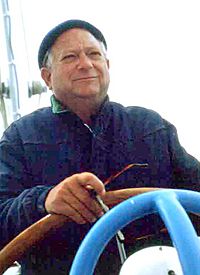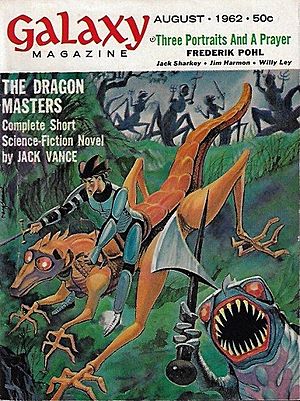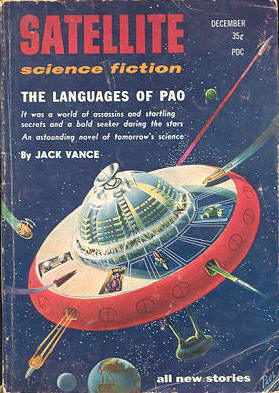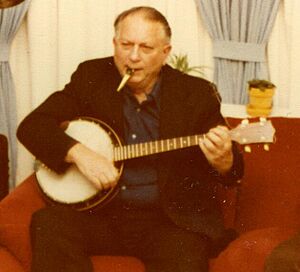Jack Vance facts for kids
Quick facts for kids
John Vance
|
|
|---|---|

Jack Vance at the helm of his boat on San Francisco Bay in the early 1980s
|
|
| Born | John Holbrook Vance August 28, 1916 San Francisco, California |
| Died | May 26, 2013 (aged 96) Oakland, California |
| Occupation | Writer |
| Nationality | American |
| Period | 1950–2009 (books) |
| Genre | Fantasy, science fiction, mystery |
| Notable works | Dying Earth |
| Notable awards | Hugo Award 1963, 1967, 2010 Nebula Award 1967 and career honors |
John Holbrook Vance (born August 28, 1916 – died May 26, 2013) was an American writer. He wrote exciting stories in the genres of mystery, fantasy, and science fiction. Most of his books were published under the name Jack Vance. He also used other names for some of his mystery novels.
Vance won many important awards for his writing. In 1984, he received the World Fantasy Award for Life Achievement. This award celebrates a writer's entire career. He was also honored at the 1992 World Science Fiction Convention. In 1997, a group called the Science Fiction and Fantasy Writers of America named him a "Grand Master." This is a very special honor for science fiction writers. In 2001, he joined the Science Fiction Hall of Fame.
Some of his top awards include:
- The Hugo Award in 1963 for The Dragon Masters.
- Another Hugo Award in 1967 for The Last Castle.
- A third Hugo Award in 2010 for his life story, This Is Me, Jack Vance!.
- The Nebula Award in 1966, also for The Last Castle.
- The Edgar Award in 1961 for his first mystery novel, The Man in the Cage.
His first stories appeared in science fiction magazines. As he became more famous, he wrote longer stories and novels. Many of his books were translated into other languages. A huge collection of all his works was published in 44 volumes. In 2010, a six-volume set called The Complete Jack Vance was released. A magazine called The New York Times Magazine once called him "one of American literature's most distinctive and undervalued voices." He passed away at his home in Oakland, California, when he was 96 years old.
Contents
Jack Vance's Early Life
Vance's family had a long history in California. His great-grandfather came to California before the California Gold Rush. He married a woman from San Francisco. Sadly, many early family records were lost in the fire after the 1906 San Francisco earthquake. Vance's grandfather, L. M. Hoefler, was a successful lawyer.
Growing Up in California
Vance grew up in a big family house in San Francisco. When his father left the family, they had to rent out their house. Vance's mother moved him and his siblings to their grandfather's ranch. This ranch was near Oakley, California, by the Sacramento River delta.
Living on the ranch made Vance love the outdoors. He also spent a lot of time reading books from his mother's large collection. He enjoyed stories like Edgar Rice Burroughs’ Tarzan of the Apes and Jules Verne's The Mysterious Island. When he visited the nearby town, he started reading exciting pulp fiction magazines.
Facing Challenges and Learning New Skills
When his grandfather died, the family faced money problems because of the Great Depression. Vance had to leave college and find work to support himself. He worked many different jobs for short times. He was a bellhop, worked in a cannery, and on a gold dredge.
Vance said this time changed him a lot. He went from being a "little intellectual" to a "reckless young man." He learned many skills and crafts. He was determined to try every part of life.
He later went to the University of California, Berkeley. Over six years, he studied many subjects. These included mining engineering, physics, journalism, and English. He even wrote one of his first science fiction stories for an English class. His professor was not very impressed.
Working and Traveling
Vance worked as an electrician in naval shipyards in Hawaii. He was paid 56 cents an hour. He also worked on a degaussing crew. The attack on Pearl Harbor happened about a month after he left that job.
He graduated from college in 1942. He could not join the military because of his weak eyesight. He found a job as a rigger at the Kaiser Shipyard. In 1943, he joined the Merchant Marine. He even memorized an eye chart to pass the test!
Boating became his favorite hobby later in life. Boats and voyages often appear in his stories. Before becoming a full-time writer in the 1970s, he worked as a seaman, rigger, surveyor, ceramicist, and carpenter.
Jack Vance's Hobbies and Family
From a young age, Vance loved Dixieland and traditional jazz music. He played the cornet and ukulele. He often used a kazoo with his music. He was also good at playing the harmonica. His first published writings were jazz reviews for his college newspaper. Music is a part of many of his books.
In 1946, Vance married Norma Genevieve Ingold. She was also a student at the Cal. Vance continued to live in Oakland, California. He built and added to his house over the years. He even had a hand-carved wooden ceiling from Kashmir.
The Vances loved to travel a lot. They went on a trip around the world. They often spent months living in places like Ireland, Tahiti, South Africa, and Italy.
Starting His Writing Career
Vance began trying to become a professional writer in the late 1940s. His first good sale was one of his early "Magnus Ridolph" stories. He sold it to 20th Century Fox. They also hired him to write for the Captain Video TV show. The money from this helped the Vances travel in Europe for a year.
In the 1950s, Vance started a hobby of making pottery and ceramics. This interest inspired his story "The Potters of Firsk" (1950).
Two other science fiction writers, Frank Herbert and Poul Anderson, were close friends with Vance. In the early 1950s, Frank Herbert interviewed Vance. They became friends and even moved to Mexico with their families to start a "writer's colony." In 1962, Vance, Frank Herbert, and Poul Anderson built a houseboat together. They sailed it in the Sacramento Delta. Vance's love for houseboats shows up in some of his stories.
In the early 1980s, Vance became very interested in sailing. He started building a 36-foot trimaran. He later owned several other boats. Even though he loved sailing, his eyesight got worse. The boats were also very expensive to keep. This led him to sell his last boat. His failing eyesight also made him stop playing jazz music.
Even though he was legally blind since the 1980s, Vance kept writing. He used special software called BigEd, made just for him. His last novel was Lurulu. After that, he wrote his autobiography, which came out in 2009.
His Passing
Jack Vance passed away on May 26, 2013. He was 96 years old. His son said he died from problems related to old age. Many famous authors, like George R. R. Martin and Neil Gaiman, shared their sadness. Steven Gould, who was the president of the Science Fiction Writers of America, called Vance "one of the greatest science fiction and fantasy writers of the 20th century."
Jack Vance's Works
Vance's first published story was "The World-Thinker" in 1945. Over his lifetime, he wrote more than 60 books. His stories fall into three main types: science fiction, fantasy, and mystery.
One of his earliest fantasy works was The Dying Earth, published in 1950. These stories are set in a very distant future. The sun is slowly dying, and both magic and technology exist.
Science Fiction and Mystery Stories
Vance wrote many science fiction short stories in the 1940s and 1950s. He also wrote many mystery novels during this time. Some of his mysteries were published under different names. Many ideas from his mystery novels later appeared in his more famous science fiction books. For example, the "book of dreams" idea appeared in his mysteries before being in The Book of Dreams. The theme of revenge is also strong in some of his mysteries.

Only two of Vance's works have been made into films. Bad Ronald was made into a TV movie in 1974. It was also made into a French film in 1992. Man in the Cage was also made into a film.
Some of his science fiction stories are also mysteries. He used his full name, John Holbrook Vance, for some of these. He also used other names like Alan Wade and Peter Held.
Vance returned to his "dying Earth" setting to write about a clever scoundrel named Cugel the Clever. He also wrote about the magician Rhialto the Marvellous. His other major fantasy work is the Lyonesse trilogy. This series is set on a group of mythical islands off the coast of France.
The Gaean Reach and Its Influence
In the 1960s, Vance created a futuristic setting called the Gaean Reach. This is a made-up area of space where humans have settled. All his later science fiction stories take place here. The Gaean Reach is always growing. Each planet in it has its own history, development, and culture. Life tends to be peaceful and focused on trade within the Reach. But at the edges, in the "lawless Beyond," things are often less safe.
Vance's writing style influenced many other authors. For example, Michael Shea wrote a sequel to Eyes of the Overworld. This book featured Cugel the Clever, before Vance wrote his own sequel.
What Inspired Jack Vance
When asked about what inspired his writing, Vance often mentioned a few authors:
- Jeffery Farnol, who wrote adventure books with a "high" or fancy language style.
- P. G. Wodehouse, whose humor and characters, especially overbearing aunts, influenced Vance.
- L. Frank Baum, who wrote The Wonderful Wizard of Oz. Vance borrowed some fantasy ideas from Baum.
Vance also read many other books as a child. These included stories by Edgar Rice Burroughs, Jules Verne, and Lord Dunsany. He also read magazines like Weird Tales and Amazing Stories. Some experts believe his early works were influenced by James Branch Cabell.
How His Books Were Published
For much of his career, Vance's books were published in magazines or as paperback editions. Sometimes, his stories were changed without his permission. As he became more famous, things got better. His books became well-known around the world. Many of his works have been translated into different languages.
Vance was a founding member of the Swordsmen and Sorcerers' Guild of America (SAGA). This group of fantasy authors worked to promote "sword and sorcery" stories.
In 1976, a small publisher called Underwood-Miller started releasing hardcover editions of Vance's books. These were high-quality, limited editions. They published many of Vance's works, including his mystery stories. Many of these editions were "the author's preferred text." This means they were not heavily edited.
The Vance Integral Edition
A very special collection of all Vance's works was published in 44 hardcover volumes. This was called the Vance Integral Edition. It was created between 1999 and 2006 by 300 volunteers working online. The texts in this edition are exactly what the author wanted. A 45th volume contains three novels Vance wrote as Ellery Queen.
In 2010, another collection called The Complete Jack Vance was released. It has six large volumes. In 2012, Spatterlight Press began offering digital versions of many of Vance's books. These e-books are based on the texts from the Integral Edition.
Stories Inspired by Jack Vance
Many writers have been inspired by Jack Vance's unique style and worlds. Here are a few examples:
- A Quest for Simbilis by Michael Shea is an authorized sequel to Vance's Cugel novel Eyes of the Overworld.
- The Archonate series by Matthew Hughes is set in a universe that changes between science and magic. This is similar to Vance's ideas.
- Phaedra: Alastor 824 by Tais Teng is an authorized novel set in Vance's Alastor Cluster universe.
- Gene Wolfe has said that Vance's The Dying Earth influenced his own series, The Book of the New Sun.
- Dan Simmons's Hyperion Cantos also shows many influences from Vance.
- The popular role-playing game Dungeons & Dragons uses a magic system inspired by Vance's Dying Earth series. In the game, magic users forget spells after casting them. This is often called 'Vancian Magic'. One of the game's villains, Vecna, is even named after Vance. His name is an anagram of "Vance."
- A Song of Ice and Fire by George R. R. Martin includes a character named "Lord Vance." His daughters are named Liane, Rhialta, and Emphyria, after characters and titles from Vance's books.
See also
 In Spanish: Jack Vance para niños
In Spanish: Jack Vance para niños





